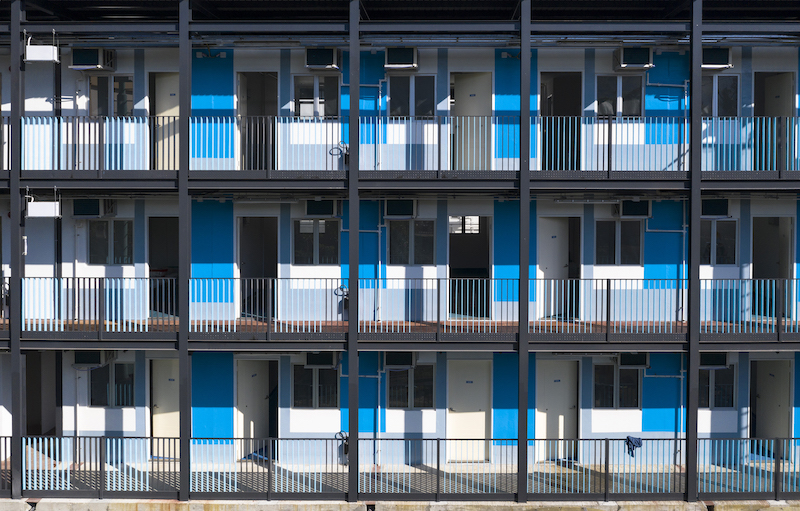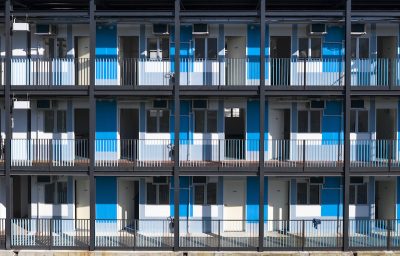Part II: Modular Integrated Construction for sustainable future
June 22, 2020
COVID-19 has brought both challenges and opportunities, as innovation flourished and new technologies found their ways to advance further. In April 2020, LWK + PARTNERS completed the temporary quarantine facilities in Sai Kung Outdoor Recreation Centre in collaboration with Paul Y. Construction and Paul Y. – iMax to assist the government’s response to COVID-19. It is one of Hong Kong’s pilot cases for Modular Integrated Construction (MiC), and it took only 77 days to design and build three blocks of three-storey facilities from scratch, setting the city’s record.
Paul Ng, LWK + PARTNERS’ director who oversees the quarantine facilities project, explained, “MiC is an innovative construction method based on the concept ‘factory assembly followed by on-site installation’. Free-standing integrated modules are fabricated, finished and inspected in the factory before being transported to the site for installation. On-site processes like foundation works can be carried out all the while the above take place, substantially raising the levels of efficiency and quality.”

Piloting an efficient, quality design in Hong Kong
Three blocks of three-storey temporary quarantine facilities were built in the mini soccer pitch of Sai Kung Outdoor Recreation Centre. Every building consists of 33 temporary units, making up a total of 99, all with their own toilets and connected through steel staircases and open-air corridors. While all the modular units were made in factories, steel staircase and semi-open corridors were built on site.
Paul shared, “A single corridor design was adopted to contain virus spread. We placed all corridors at the front of the building and the bathroom vents at the back. The blocks are arranged front-to-front or back-to-back to ensure a clear divide of ‘clean’ and ‘dirty’ air.”
Transporting huge modular units posed a major difficulty. “Due to their massive size comparing to ordinary construction material, these units must be transported by sea and then overland. Site constraints must also be overcome to get them properly delivered. Border restrictions during the pandemic also meant that the modules could not be manufactured on the mainland. The team quickly turned to Malaysia and managed to complete the project within a limited time frame,” said Paul.
Raising industry resilience and sustainability
With MiC, a lot of on-site work can be transferred to the factory. Quality control becomes more effective, improving the standards of delivery. Factories are weather-proof and provides a better work environment, potentially drawing new blood into the industry, which bolsters both capacity and resilience.
As the total construction period is shortened, MiC brings down the costs of labour and building materials, while carbon emissions and possible nuisance to the community are reduced. It will also speed up market supply to better accommodate long-term demand for housing and function space in dense cities.
But more importantly, it presents a potential driving force for sustainable development and circular economy.
“MiC leads to less construction wastage and raises cost-effectiveness overall,” Paul noted. “Modular units can also be brought back to the supply chain to be ‘reused’, extending the life-cycle of building materials and relieving the pressure on the planet’s resources. At the Sai Kung temporary quarantine facilities, the project team has designed certain flexibility in the units so that they can be reused in transitional housing in the future.”
Architecture will never be the same
The global trend of MiC points to a new approach to building, shaping workflows and the way projects are planned and designed. The building industry is set for a revolution.
In a bid to promote wider use, the Hong Kong government announced a policy in March, making MiC a requirement in future tenders for specified types of public capital works projects, including staff quarters, hostels, residential and care homes, schools, office buildings and medical facilities, as well as staircases and communal areas of the above where possible. This applies to tenders where the total construction area exceeds 300 square metres.
Though MiC is now predominantly used in the public sector, it is expected to expand to different types of real estate as technology progresses, affecting the industry in Hong Kong, the Greater Bay Area, the whole mainland China and Southeast Asia. The expanded use of MiC promises efficiency and quality, helping firms respond with agility and timeliness to the rising demands for the built environment on the back of a growing urban population across the world.
Read Part I of the post-disaster/recovery story of COVID-19 here: https://www.futurarc.com/commentary/covid-19-an-urgent-need-for-emergency-architecture/
To read the complete article, get your hardcopy at our online shop/newsstands/major bookstores; subscribe to FuturArc or download the FuturArc App to read the issues.
Previously Published Commentary, Online Exclusive Feature
Contact us at https://www.futurarc.com/contact-us for older commentaries.


